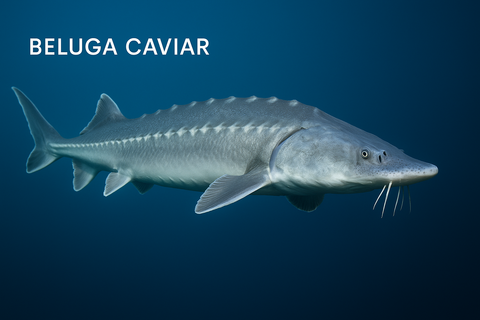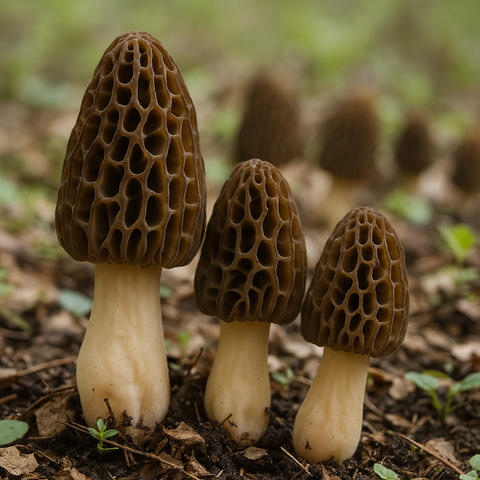Caviar has long been considered the pinnacle of culinary luxury, enjoyed for centuries by royalty, aristocrats, and modern-day gourmands alike. But while many people associate the term "caviar" with any type of fish roe, the truth is more specific: true caviar only comes from one group of fish — sturgeon. Understanding which fish provide caviar, and how they differ from other types of roe, helps explain why caviar is so highly prized and often so expensive.
The Origin of Caviar: Sturgeon
The word “caviar” traditionally refers to the salted eggs (roe) harvested from sturgeon, a group of ancient fish that have existed for over 200 million years. Sturgeon are large, slow-maturing fish found in both freshwater and saltwater environments across the Northern Hemisphere. There are more than 25 species of sturgeon, but only a handful are commonly used to produce caviar.
The most famous types of sturgeon caviar include:
-
Beluga Caviar – Harvested from the beluga sturgeon (Huso huso), this is the rarest and most luxurious caviar. The eggs are large, delicate, and have a buttery, nutty flavor. Beluga caviar has long been the most expensive in the world.
-
Ossetra (or Osetra) Caviar – Coming from the Russian sturgeon (Acipenser gueldenstaedtii), Ossetra caviar is medium-sized with a firm texture. Its flavor profile is complex, often described as nutty with a hint of the sea.
-
Sevruga Caviar – From the sevruga sturgeon (Acipenser stellatus), this caviar has smaller eggs but packs an intense, briny flavor. It is more abundant and therefore more affordable than Beluga or Ossetra.
-
Kaluga Caviar – Harvested from the Kaluga sturgeon (Huso dauricus), often called the “river beluga,” this caviar offers large, glossy eggs with a rich, buttery taste similar to Beluga.
Each sturgeon species produces eggs of different size, color, and taste. The variations in flavor are influenced by the fish’s diet, habitat, and age.
Beyond Sturgeon: Roe vs. Caviar

Today, the word “caviar” is sometimes used more loosely to describe the roe of other fish. However, purists insist that only sturgeon eggs deserve the name. Fish eggs from non-sturgeon species are correctly referred to as roe, even if they are marketed as “caviar” with a qualifier (such as “salmon caviar” or “lumpfish caviar”).
Some popular types of non-sturgeon roe include:
-
Salmon Roe (Ikura in Japanese cuisine) – Large, bright orange eggs with a briny, slightly sweet flavor. Commonly used in sushi.
-
Trout Roe – Similar in color to salmon roe but smaller, with a milder flavor.
-
Lumpfish Roe – Small, crunchy eggs often dyed black or red, frequently used as a garnish.
-
Paddlefish Roe – From the American paddlefish, this roe is sometimes marketed as a domestic alternative to sturgeon caviar. It has a flavor and appearance similar to Sevruga.
-
Tobiko (Flying Fish Roe) – Tiny, crunchy eggs used in sushi, often dyed bright colors such as red, green, or black.
While these varieties of roe are delicious and widely enjoyed, they lack the depth, history, and prestige associated with sturgeon caviar.
Why Sturgeon Caviar Is Special
Several factors set sturgeon caviar apart:
-
Rarity – Sturgeon take years, sometimes decades, to reach maturity and produce roe. This makes the supply of true caviar limited compared to other fish roe.
-
Flavor Complexity – Sturgeon eggs are prized for their delicate, buttery, and nutty flavors, with subtle differences between species. Other roe tends to have a more straightforward salty or briny taste.
-
Tradition – Sturgeon caviar has been treasured in Russia, Persia (Iran), and Europe for centuries. Its role in history as a food of kings and nobility has reinforced its image as the ultimate delicacy.
-
Conservation Challenges – Overfishing and habitat loss have made many sturgeon species endangered, which further elevates the value and exclusivity of their caviar. Today, most caviar comes from farm-raised sturgeon to support sustainable practices.
The Modern Caviar Market

Due to conservation concerns, wild sturgeon caviar is now rare and tightly regulated. Most of the caviar available today comes from aquaculture, where sturgeon are raised in carefully managed environments. This ensures not only sustainability but also consistent quality. Countries like the United States, Italy, China, and Israel have become leading producers of farmed caviar, making it more widely available to global markets.
Meanwhile, roe from salmon, trout, paddlefish, and lumpfish continue to provide affordable alternatives for those seeking the look and taste of fish eggs without the high price tag of sturgeon caviar.
Conclusion
So, what fish does caviar come from? True caviar comes only from sturgeon. Beluga, Ossetra, Sevruga, and Kaluga are among the most celebrated types, each with unique textures and flavors. While roe from salmon, trout, paddlefish, or flying fish may also be marketed as caviar, they are technically not the same.
The exclusivity, tradition, and extraordinary flavor of sturgeon caviar make it one of the most coveted delicacies in the world. Whether enjoyed on its own with a mother-of-pearl spoon, paired with champagne, or used to elevate gourmet dishes, caviar remains a timeless symbol of elegance and indulgence.
Shop Caviar




